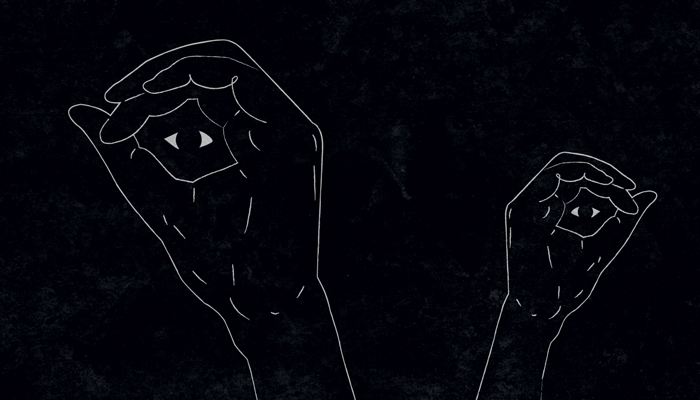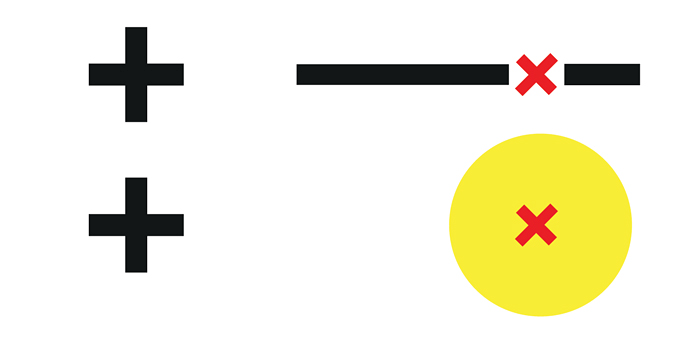
First described by Edme Mariotte in the 1660s, the physiologic blind spot (PBS) – also known as the punctum caecum – is an area in the monocular visual field where the eye does not register physical vision because of a lack of photoreceptors (an absolute scotoma). Although no photoreceptors are present, incredibly, in terms of function, there is no visual defect in the binocular visual field.
Measuring about 7.5 degrees in height and 5.5 degrees in width, the PBS occurs in the area of the eye where the retinal ganglion cells pass through the optic disc to form the optic nerve. Since, in most cases, retinal ganglion cells are not sensitive to light, no vision is detected in this area of the eye.
Interestingly, although all vertebrates have a PBS, cephalopods – including squids, octopuses, and chambered nautiluses – do not. The visual organs in cephalopod vary in complexity (the nautilus’ eye is made up of a simple optic cup, whereas the octopus eye is a similar structure to the human eye) but the visual fibers are everted in them all; they leave the photoreceptors from behind (deep to the retina) and thus not causing a break in the visually sensitive photoreceptor layer as they emerge from the inner eye toward the optic disc.
Mitigating the absence
Vertebrates, including humans, are able to mitigate the absence of photoreceptors using two methods: interpolation and binocularity.
Interpolation describes the ability of the visual system to “fill in” the missing visual information resulting from the lack of photoreceptors in the PBS. This is an active process as opposed to simply ignoring the absence of visual information in the physiologic scotoma. Additionally, it appears that this process is mediated by visual information recognized at the edge of the scotoma. Studies have shown that this process occurs in early visual cortical areas and differs for color, brightness, texture, and motion (1).
Binocularity describes the ability of the visual system to combine the visual stimuli originating from each eye into a single visual percept. In this case, although each eye has its own PBS, they do not project to the same areas of the visual field. This means that visual information from both eyes can be combined to form a complete binocular visual field. Research has shown that this process most likely occurs very early in visual processing, likely at the level of the primary visual cortex (2).
Observing the ocular
Figure 1 highlights how the PBS affects the visual field. By closing the left eye, fixing on the black "+" sign with the right, and moving back and forth from the page, there comes a moment where the black dot to the right of the "+" sign vanishes. Moving closer or further will bring the image back, but the moment it falls within the area devoid of photoreceptors, it will disappear.
To demonstrate how binocularity aids vision despite the image of the dot falling on an absolute scotoma, simply repeat the above exercise and maintain the distance where the dot disappears. When achieved, open the left eye and immediately, the black dot will reappear as its image falls on the photosensitive retina in the newly opened left eye, and is therefore seen in the binocular visual field.

Finally, we can highlight the effects of interpolation by using either of the two diagrams in Figure 2a. If we close our left eye and maintain a steady fixation using the right eye on the black "+", repeating the movements described above, there will come a time when the red "X" disappears as its image falls within the scotoma. Interestingly – where broken by the red “X” before – after completing this exercise, the black line will appear to be complete. This is a perfect example of interpolation. The photosensitive retina at the border of the PBS senses the black line and simply "fills it" in when the portion containing the red “X” is no longer visible. Figure 2b is similar, but in this case, the visual system replaces the red “x” with a uniform yellow pattern.

Despite the presence of PBS, the lack of damage to the visual field in each eye is a testament to the importance of non-ocular structures in vision. Certainly, the eye itself is a critically needed element in human vision, but the processing of visual information centrally is of equal (if not greater) importance in our day-to-day experience of the visual world around us.
References
- H Komatsu, “The neural mechanisms of perceptual filling-in,” Nat Rev Neurosci, 7, 220 (2006). PMID: 16495943.
- F Tong, SA Engel, “Interocular rivalry revealed in the human cortical blind-spot representation,” 411, 195 (2001). PMID: 11346796.
